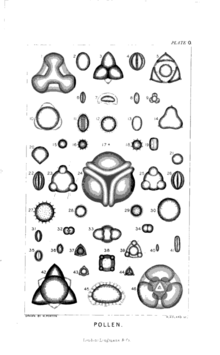Pollen calendar
A pollen calendar is used to show the peak pollen times for different types of plant pollen, which causes allergic reactions in certain people.[1][2][3]
| Part of a series on |
| Forensic science |
|---|
 |
|
In forensics
A pollen calendar can be a very useful tool in forensic science, because it can be used to place the month, or week, or date of death.[4][5] The use of pollen for criminal investigation purposes is called "forensic palynology".[6][4]
However, the use of a pollen calendar to set the date of death should be used with extreme caution, and only by a carefully trained expert witness.[7] The CSI effect has put pressure on some police officers and district attorneys to provide pollen-based evidence, but such evidence "appear[s] to be of limited use in the forensic context where outcomes are scrutinised in court."[7]
References
- "Pollen calendar". Food Allergy Information. Archived from the original on February 26, 2015. Retrieved February 22, 2010.
- "HON Allergy Glossary, World Pollen Calendar". Health On the Net Foundation. Archived from the original on May 28, 2017.
- "Pollen Calendar". National Pollen and Aerobiology Research Unit (UK). Archived from the original on May 16, 2008.
- E. Montali, A. Mercuri, G. Trevisan Grandi, and C. Accorsi. "Towards a 'crime pollen calendar'—Pollen analysis on corpses throughout one year." Forensic Science International, Volume 163, Issue 3, pp. 211–223. Abstract found at ScienceDirect website. Accessed February 22, 2010. Archived April 15, 2020, at the Wayback Machine.
- Ray Palmer. "THE FORENSIC EXAMINATION OF FIBRES – A Review: 2004 to 2007." Interpol paper, p. 80. Found at Interpol website (PDF). Accessed February 22, 2010. Archived October 11, 2010, at the Wayback Machine.
- D.C. Mildenhall, P.E.J. Wiltshire, and V.M. Bryant. "Editorial: Forensic palynology." Forensic Science International, Volume 163 (2006), pp. 161–162. Found at Texas A & M University website (PDF). Accessed February 23, 2010.
- Patricia E. J. Wiltshire. "Forensic Ecology, Botany, and Palynology: Some Aspects of Their Role in Criminal Investigation," in Criminal and Environmental Soil Forensics (Springer Netherlands 2009), pp. 129–149. ISBN 978-1-4020-9203-9 (print), 978-1-4020-9204-6 (online). Found at SpringerLink website. Accessed February 23, 2010. Archived June 9, 2018, at the Wayback Machine.
External links
- United States pollen calendars (Does not lead to any pollen calendars)
- Pollen calendar for the UK created by the National Pollen and Aerobiology Research Unit at the University of Worcester
- New Zealand allergy pages and New Zealand pollen calendar (printable PDF)
- Australian pollen calendar (printable PDF)